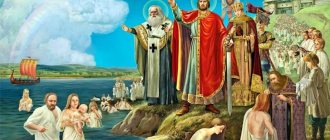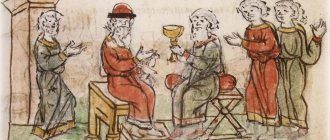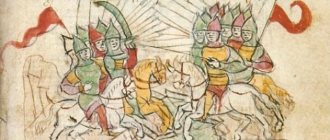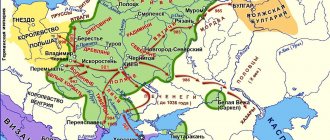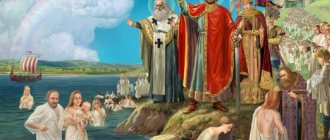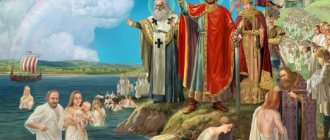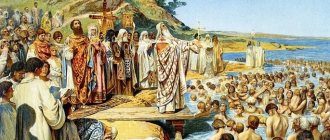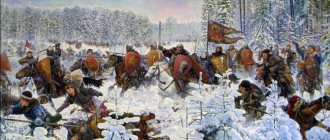4.6
Average rating: 4.6
Total ratings received: 2654.
4.6
Average rating: 4.6
Total ratings received: 2654.
The Baptism of Rus' was of great importance in Russian history. Pagan beliefs were replaced by a national unified religion. The adoption of Christianity from Byzantium predetermined the future path of development of Russia as the largest stronghold of Orthodoxy.
The material was prepared jointly with a teacher of the highest category, Ekaterina Valerievna Alexandrova.
Experience as a history and social studies teacher - 11 years.
Is the Baptism of Rus' a political move by Prince Vladimir?
Zlatnik of Prince Vladimir Svyatoslavich. 980–1015 State Hermitage
The Baptism of Russia is a conventional concept, behind which stands a whole series of decisions and events associated with different people and occurring at different times. Of course, the personal role of Prince Vladimir Svyatoslavich in the fact that the people of Rus' became Christian is great, but to reduce the whole matter to him alone from a historical point of view would be completely wrong. Vladimir is a kind of symbol of the adoption of Christianity by the Eastern Slavs. That is why he is revered as an Orthodox saint and is depicted in the images of historical memory (icons, paintings, monuments, and so on) of modern peoples who emerged from medieval Rus' - Ukrainians, Belarusians and Russians.
First of all, it is necessary to distinguish between the decision of the prince himself and some of his close relatives to accept baptism and the desire of the ruling elite of the Kyiv state to reject pagan cults and accept Christianity as the official and obligatory religion for the entire population. In addition, the introduction of an official and mandatory religion for everyone could not happen in one day and from scratch: an event of such a scale had many different prerequisites (and not only political, but economic and cultural).
When discussing the events of a thousand years ago, one must understand that very few sources from the reign of Vladimir have survived, and those that have survived are difficult to interpret unambiguously. In fact, only a few brief and fragmentary foreign messages have reached us, as well as some objects: for example, coins that began to be minted at the beginning of the 11th century at the court of the already baptized Vladimir, with his image as a Christian ruler (the prince is depicted with a cross and other attributes of the Christian faith , an image of Jesus was usually minted on the reverse side of the coin). Izvestia This is how chronicle messages are usually called in historiography. The Kyiv Chronicle and some other ancient Russian texts about the Baptism of Rus' were written down many decades after the death of the prince, and mostly these are just legends.
“The Tale of Bygone Years” “The Tale of Bygone Years” is an ancient Russian chronicle compiled in Kiev in the 1110s. Of several editions, two have reached us: as part of the Laurentian and Ipatiev Chronicles, which underlies the most common ideas about the events of that time, took a long time to develop. In the middle of the 11th - beginning of the 12th century, it was edited by several Kyiv scribes, so many contradictions can be found in the text. It is rather the fruit of historical and literary creativity, partially and distortedly telling about real events. It is not the “presumption of innocence”, but rather the “presumption of mistrust” that determines the attitude of modern historians towards him.
Bearing in mind all these circumstances, we must, firstly, admit that we cannot know the real motives of Prince Vladimir, who decided to be baptized, and secondly, that the decision to adopt Christianity as the state religion was a consequence of the interests of the elite of Kievan Rus and objective needs of this state.
What kind of faith was there before Baptism?
It is defined as the so-called pagan, from the Slavic “language”, or “people”. This suggests that the faith of the Slavs was determined by a kind of collective experience of understanding the world and nature. Very little data has been preserved about the paganism of Rus'. They are given:
- data from ethnographers, back at the beginning of the 20th century. who observed some rituals dating back to paganism; elements of a long-gone faith preserve the traditions of embroidery patterns and features of Slavic clothing;
- research by folklorists who wrote down not only songs, riddles, proverbs, but also many fairy tales containing elements of the pagan Slavic worldview;
- finally, Russian chronicles report some names of Slavic gods and some details about rituals.
The main features of religion include:
- polytheism;
- magic, when the basis of interaction with nature, spirits, and gods are various types of magical practices.
If so, then when was Vladimir himself and his loved ones baptized, and when was the rest of Rus'?
Council of Vladimir Svyatoslavich with the boyars and squad about the place and time of the adoption of Christianity by Russia. Miniature from the Radziwill Chronicle. Late 15th century Library of the Academy of Sciences in St. Petersburg
According to the Tale of Bygone Years, the baptism of Prince Vladimir and his “squad,” that is, the Kiev elite, took place in Chersonesos in 988. In the same year, but a little later, when Vladimir and his army returned to Kyiv, by order of the prince, the people of Kiev were to be baptized. According to the Novgorod Chronicle, soon, although it is not known exactly when, baptism took place in Novgorod.
The Tale of Bygone Years speaks about baptism in other cities and regions subject to Kyiv:
“And [the prince] began to install churches and priests throughout the city, and bring people to baptism throughout the city and village. And, having sent, he began to take children from the deliberate child and give them for book teaching. And the mothers of their children wept for them, and for fear they had not yet confirmed their faith, but as if they were weeping for a dead man.” “And in other cities [the prince] began to build churches and appoint priests in them and bring people to baptism in all the cities and villages . He sent to collect children from the best people and send them to book education. The mothers of these children wept for them, for they were not yet established in the faith, and wept for them as if they were dead.” The Tale of Bygone Years. St. Petersburg, 1996. .
But there is another ancient text that describes a different chronology of the baptism of Vladimir and Rus'. This is the so-called “Memory and Praise to the Russian Prince Vladimir” by Jacob Mnich (that is, the monk), probably written in the middle of the 11th century. Jacob writes that the baptism of Vladimir and the capture of Chersonesos were not directly related. The prince was baptized in Kyiv back in 987, and captured Chersonesus and married Anna of Byzantium not in 988, but in 989.
In fact, the chronicle does not explain the reasons for the capture of Chersonesos. And in the text of Jacob and some other sources it is written that Vladimir decided to take the city in order to obtain the extradition of Princess Anna from Byzantium - the imperial family, apparently, desperately did not want to become related to the wild barbarian that the Greeks imagined the prince to be. Modern scholars have serious reasons to believe Jacob rather than the Tale of Bygone Years.
We have no other data on the chronology of Baptism, but it is clear that the Christianization of the entire population over a vast territory from the Black Sea steppes to the Novgorod forests could not take place in one day or even one year. The above quotation from The Tale of Bygone Years implies this by noting that many “have not yet become established in the faith”—obviously, “establishment” must have taken a long time.
How did the population accept the new faith?
Data on this are scarce and therefore very contradictory:
- on the one hand, it is obvious not only resistance to Christianity, but also a shallow understanding of it: for example, pagan customs were preserved for a long time, and Russian princes until the 13th century. at birth they received two names - Christian and pagan (for example, even the names of St. Boris and Gleb are pagan, and they were baptized as Roman and David);
- on the other hand, the first decades of Christianization became a time of such a rise in spiritual life that it even caused some bewilderment among the Byzantines: the Kiev Pechersky Monastery appeared, without exaggeration, the spiritual heart of the country, and in Kiev alone there were up to 1000 churches; finally, within a few decades, the young Church received its first saints, moreover, martyrs for the faith - these are the same saints. Boris and Gleb, who chose to die rather than participate in the fratricidal civil strife.
Therefore, we can say that the spiritual rebirth of the country took place, perhaps not quickly, but thoroughly. An indicator of this is the fate of Slavic paganism, about which so little is now known.
Kiev-Pechersk Lavra, Kyiv
As a functioning, integral religion, paganism apparently ceased to exist by the end of the 13th century, if not earlier. And the attempts of modern neo-pagan movements to “revive” the “faith of our ancestors” from the point of view of most professionals are not even historical reconstruction, because there is almost no material for it. They blame, of course, Prince Vladimir, who allegedly forcibly baptized Rus'.
The truth is much more unpleasant for opponents of Christianity: no violence can compare with the kind of “self-censorship” of the Russians: accepting the faith, albeit not immediately, not at once, they so decisively abandoned their previous errors that after several generations it was time to collect the fragments of the “fatherly faith” - But Christians didn’t need it...
Were there any other options besides Orthodoxy?
Grand Duke Vladimir chooses faith. Painting by Ivan Eggink. 1822 State Museum of the History of Religion, St. Petersburg
The answer to this question can be found in the ancient Kiev chronicle, which was included in the Tale of Bygone Years. Its author, a chronicler who most likely lived in the second half of the 11th century, compiled the so-called story “about the choice of faiths.” In the “Tale of Bygone Years” under the years 986–987, it first says that proselytizers came to the court of the Kiev prince Vladimir Svyatoslavich. Proselytism is an activity aimed at converting people of other faiths to their religion. embassies of Mohammedans, Jews, Catholics and Orthodox Christians, and then that the prince himself, after consulting with the “boyars and elders” - the elite of the then society - sent his ambassadors to the Volga Bulgarians, the “Germans”, that is, the Catholics. and the Greeks “to experience the service of how to serve God” Tale of Bygone Years. St. Petersburg, 1996. .
This legendary story was based on folklore and literary motifs. But its essence reflected reality: in Kievan Rus they knew about different religions that were common in neighboring countries. The story “about the choice of faiths” says that Jews from Khazaria, Muslims from Volga Bulgaria, as well as Christians from Rome and Constantinople came into contact with Kiev. Sources independent of the chronicle, although they do not confirm exchanges of embassies at this time, do indicate contacts with these peoples in the religious sphere in the 10th century. For example, Princess Olga, Vladimir’s grandmother, was actually baptized in Byzantium. However, later, according to German sources, she, dissatisfied with political relations with Byzantium, turned to the German king Otto I with a request to send a bishop and priests to Rus'. In 961, a German bishop even arrived in Kyiv, but his mission (he was supposed to convert Rus' to Catholicism) ultimately failed.
Prince Yaropolk Svyatoslavich, Vladimir’s elder brother and his predecessor on the Kiev “table,” that is, the throne, also had contacts with the German imperial court. Some historians, not unreasonably, believe that Yaropolk even managed to receive Catholic baptism before the war with Vladimir, in which he died.
On the other hand, no later than the middle of the 10th century, a Jewish community was formed in Kyiv. This is evidenced by the oldest document created in Kievan Rus - the so-called Kievan letter, a message in Hebrew on behalf of this community, preserved in the Cairo Geniza - the archive at the synagogue. It was about financial assistance to one of the community members. Unfortunately, this message does not have an exact dating, but scientists place it around the middle of the 10th century. Among the names of community members there are Slavic ones, and this directly confirms Jewish proselytism in the capital of Rus'.
There is no direct evidence of Islamic proselytism on the territory of Rus'. But in Rus' they knew exactly what Islam was: since the 9th century, it was united by close, primarily trade and economic, but also military contacts with Volga Bulgaria and the Arab Caliphate. We have a variety of evidence about these contacts (including from Arabic sources of the late 9th - early 10th centuries), and often in the form of detailed stories.
Theoretically, the elite of the Kyiv state could turn to different countries with a request for help in establishing a monotheistic religion. A Western alternative was also possible, that is, the adoption of Christianity from the Roman Curia through Germany.
But Orthodoxy, which came from Constantinople, had the greatest chances: back in the 9th century, Christianity began to spread from there to the north, mainly to the Slavic regions. Naturally, for Dnieper Rus', the path to breaking with paganism led to Byzantium, with which the ruling elite of Rus' had the closest trade and economic relations. Arab writers report that at the end of the 9th century, some merchants from Rus' who came to the Arab Caliphate said that they had been baptized.
Of great importance is the evidence of the treaty between Russia and the Greeks in 944, which was included in the “Tale of Bygone Years” in a copy with a translation into Church Slavonic. Some of those who concluded it from the Russian side were Christians and swore according to Christian rites, that is, they kissed the cross. And among the archaeological finds of the late 9th - early 10th centuries there are objects of Christian worship: crosses, candles and the like.
The Baptism of Rus' and the legacy of paganism
Why did Vladimir choose Christianity? Lecture from the course “History of Russian Culture”
At what year?
According to the chronicle, Vladimir himself was baptized in 988.
In the same year, 988, a long process of acceptance of the faith by the Eastern Slavs began - but its final “point”, when Rus' truly became “Holy”, Orthodox, is difficult to determine.
Did it emerge Christian , having been tested, like gold in a crucible, from the timelessness of Mongol rule? Should we consider the existence of Christian Rus' since the 14th century, when St. Sergius of Radonezh? Or maybe from the 16th century, when the word “peasant” first appeared, what does “Christian” mean? Is this what rural producers call themselves, putting faith rather than their work at the forefront? The issue has definitely not been resolved to this day.
Is the exact date of the event known?
No. History has not preserved the day or month.
What would have happened if Rus' had not been baptized? Would we remain pagans?
The reign of Vladimir Svyatoslavich in Kyiv; the erection, at his command, of wooden figures of the god Perun and other pagan deities on the hill. Miniature from the Radziwill Chronicle. Late 15th century Library of the Academy of Sciences in St. Petersburg
Probably, for some time paganism could exist in Russia as the main cult. In any case, it is known that in neighboring Poland, after the adoption of Christianity at the end of the 10th - beginning of the 11th century, a period of pagan reaction began (it was expressed in a series of uprisings against the ruling Piast dynasty in the 1030s), and in more distant Scandinavia Christianity remained for a long time ( until the end of the 12th century) gained ground. But paganism was doomed to disappear. There is an example of some West Slavic tribes (Polabian Slavs - Obodrits, Lutichs and others), who, in the face of German aggression in the 10th-12th centuries, acting under the slogans of baptism, “mothballed” their pagan beliefs. For some time, this conservation helped them defend their original culture and political independence, but by the end of the 12th century they lost their independence and became part of the German states. But those Slavs who adopted Christianity were just able to defend their independence.
How all of Rus' was baptized
Apparently, during the Christianization of the country, things could not be done without the confrontation between paganism and the new faith. For example, it is known that:
- the inhabitants of Murom categorically did not accept Prince Gleb, the son of Vladimir, who tried to establish Christianity here; he was forced to establish a residence outside the city walls;
- The Vyatichi killed the missionary monk St. Kuksha from the Kiev-Pechersk monastery;
- The Drevlyans, neighbors of the Polyans (on whose territory Kyiv was located), were the last to accept the faith - they could not forget how Princess Olga, while still a pagan, cruelly took revenge on them for the death of her husband, Igor.
But only one case of truly violent “baptism by fire and sword” was recorded - this was Novgorod, where, however, there were serious political reasons for open rebellion - opposition to Kyiv as the leader of the country, in addition, hostility towards Vladimir personally. Mass forced conversion of Russians should be considered extremely unlikely: the then grand ducal power was too weak for this.
Ilya Glazunov. "Baptism of Novgorod"
Was Rus' forcibly baptized?
Baptism of Rus'. Sketch by Viktor Vasnetsov for the painting of St. Vladimir's Cathedral in Kyiv. 1890 State Tretyakov Gallery
The oldest sources do not report any violence: neither from other states, nor from the Kiev authorities. The literature still refers to reports of some resistance to baptism with armed confrontation (for example, in Novgorod), but this is unreliable information based on later speculation and legends.
Was there resistance and protests?
Prince Gleb Svyatoslavovich kills the sorcerer at the Novgorod Veche (Princely Court). Painting by Andrey Ryabushkin. 1898 Nizhny Tagil Museum of Fine Arts
We know nothing about resistance and protests in the era of Vladimir. Another thing is that the Christianization of the entire population of Rus' was a long process: the chronicle reports some unrest in individual cities and regions of Rus' later, in the 11th century. To varying degrees, the protesters used slogans of pagan reaction. For example, in Suzdal in 1024 there were unrest due to famine, and pagan Magi (priests) took an active part in them. Under the year 1071 (in reality, the events most likely took place in 1074), the Tale of Bygone Years describes the adventures of the Kyiv boyar Yan Vyshatich in the Upper Volga region. Famine reigned in Rus' at that time, and unrest against the authorities began. Jan had to suppress them and even conduct a theological dispute with the Magi, who were depicted as the leaders of the protest. In Novgorod in 1071, a revolt against the prince and bishop was also led by a certain sorcerer; unrest occurred during the evening, but the decisive actions of the prince and his squad stopped them.
Popularization of Christianity
Photo: Pravzhizn.ru
An important step forward for the development of the Christian religion in Russia was the activity of Yaroslav the Wise, who was also the son of Vladimir. Yaroslav enjoyed enormous authority not only in Rus', but also in other European countries. Yaroslav's activities were always aimed at raising the status of Rus' to the level of the Byzantine Empire.
- The prince paid great attention to the important educational mission. Yaroslav understood that his subjects would simply go wild and begin to gradually degrade if religious centers did not appear around them, and spiritual literature remained inaccessible.
- Priests from Bulgaria, Greece, and Serbia began to arrive at the monasteries that had been opened in Rus' by that time. They brought with them ancient writings, church utensils, and books on worship. Soon they began to be translated into Russian.
- The position of a scribe appeared who was obliged to rewrite the Holy Scriptures. Christianity played an important role in the development of the Russian people, thanks to this, many mastered literacy.
- Yaroslav founded a large-scale library in which everyone could find the necessary theological knowledge. Clergymen could receive benefits here for opening Sunday schools and conducting sermons.
- The Prince created the Charter, which formulated the requirements for human moral behavior.
After that, did they immediately start building churches and painting icons?
The consecration of the Mother of God (Tithe) Church in Kyiv, built by order of Vladimir Svyatoslavich by Greek craftsmen and decorated with icons and utensils from Korsun, and the appointment of Anastas and other Korsun priests as ministers in it. Miniature from the Radziwill Chronicle. End of the 15th century Library of the Academy of Sciences in St. Petersburg
The chronicle reports that after mass baptism in Kiev, by order and at the expense of the prince, they began to “set up churches and priests throughout the city” The Tale of Bygone Years. St. Petersburg, 1996.. It specifically talks about the construction of the Tithe Church of the Virgin Mary in the city. It began to be called tithe because a tenth of the prince’s income was allocated to support it. The church was a very representative building; it was decorated with mosaics and frescoes. It was severely damaged during the capture of the city by the Mongols at the end of 1240, and then gradually collapsed until the 20th century. Archaeologists discovered its foundation (which can still be seen today) and confirmed that the church was built at the end of the 10th century. It is known that after the death of Vladimir in 1015, there were already hundreds of churches in the city: in addition to the Tithe Church, the then wooden St. Sophia Cathedral and other large churches, numerous small private churches and chapels were also built. Obviously, they must have had some kind of icons, but the oldest surviving icons of pre-Mongol Rus' date back to no earlier than the middle of the 11th century.
Why Princess Olga failed to instill faith in her son Svyatoslav
First of all, because at the time of the spiritual rebirth of the pagan princess, who became a Christian, he was an adult, an established personality. At the same time, the prince:
- had state views that were different from those of his mother: while Olga cared about the spiritual unity of the country, Svyatoslav was more interested in conquering new territories, controlling trade, and making a profit;
- like any prince, he was heavily dependent on his squad, most of which were pagan; Svyatoslav seriously feared that internal conflicts would not give him the opportunity to continue effective military campaigns.
For these reasons, respecting his mother’s beliefs, the prince did not share them, remaining an adherent of paganism until the end of his days. At the same time, the chronicler, speaking about Svyatoslav, does not utter a word of condemnation; on the contrary, he admires his military talents, courage, and honesty: of course, in his own way he was an integral, sincere person who was just as sincerely mistaken. However, Svyatoslav apparently never forbade his mother to raise his children – Olga’s grandchildren – Christianly.
“Olga’s Baptism” – art. S. A. Kirillov, 1993
And everyone started wearing crosses?
The pendant cross is one-sided. Veliky Novgorod, late 11th century Institute of Archeology RAS
Yes, after baptism, many actually began to wear crosses. In the graves of the 11th century, burials in which were performed according to Christian rites, the dead, as a rule, lie with crosses. In chronicles and other texts of the late 11th - 12th centuries, the custom of wearing a pectoral cross is already mentioned as a matter of course and universal.
Epiphany Christmas Eve
Anton Ovsyannikov.
Great Blessing of Water in the Jordan. 2002. Private collection Epiphany Eve, like Christmas Eve, was called Christmas Eve. The Epiphany meal was in many ways the same as the Lenten Christmas menu. Kutya porridge and ritual bread, a variety of pastries, pancakes, and desserts made from dried fruits and nuts were placed on the table. Housewives prepared only an odd number of dishes for Epiphany. Due to the fact that this day was considered fast, Epiphany Christmas Eve was popularly called hungry kutya. In many regions, the Christmas ritual of inviting deceased ancestors to dinner was repeated at Epiphany. A candle was lit on the table for the dead, and additional cutlery was placed according to the number of deceased relatives.
Before Epiphany they said goodbye to the Christmastide. The hay that had been solemnly brought in on the eve of Christmas was cleared from the table. Since Christmas, holiday bread has been lying near the icons, which was fed to cattle or poultry at Epiphany. During the entire 12 holy days, it was forbidden to take out the trash, and also to do many household chores, such as spinning and weaving. At Epiphany, these prohibitions were lifted - the dirty linen was taken out of the hut, the ashes were swept out of the stove.
That same evening, the youth organized the final games. Mummers walked around the courtyards singing carols - songs with wishes to the owners of the house. It was believed that the more carolers the owners gave, the more good things would happen to the family in the new year.
“In Toropets, Pskov province, Christmastide is known as “Saturdays.” Then the unmarried daughters of the inhabitants of this town gather with the poor widows... for visitors they make benches with ledges from floor to ceiling in the form of an amphitheater. On the sides of the same room there are benches for men. When the girls have gathered... the gates open and the arrival of single young people begins. The girls celebrate the arrival of each young guest with songs that have been sung at Saturdays since ancient times. For this honor, each guest must pay with money, which is then given in favor of the mistress of the house, a poor widow. Married people are not allowed here.”
Mikhail Zabylin, “Russian people. Its customs, rituals, legends, superstitions and poetry", 1880
The eve of Epiphany was considered especially “true” in terms of predictions. On the one hand, at this time, as on all holy days, unclean forces walked the earth - the main assistants for fortune telling. On the other hand, the subsequent church service expelled them and closed their gates to the earthly world, so there was no need to be afraid of “complications” from communicating with otherworldly forces. Nevertheless, it was customary to observe safety measures. For protection during fortune telling, they drew a circle around themselves. If there were a lot of fortune tellers, they stood in a “round dance”, holding each other’s little fingers. In the Vologda province, the rules of “fortune-telling safety” prescribed that a clay pot should be placed on the head. In the Kostroma province, before fortune telling, the place where it was carried out was jumped on the left foot against the sun (counterclockwise), saying: “Damn place, to hell with you!” After fortune telling, they jumped on their right leg clockwise with the words: “God’s place, God is with you!” - in order to “unwind”.
As at Christmas, on the night of Epiphany they made a wish: it was believed that the sky “opens” and any request reaches the Savior. A sign that the heavens had opened was the swaying of water in a barrel or glass. It symbolized the moment when Christ entered the Jordan River to be baptized.
Where did the priests and other clergy come from?
Baptism of Princess Olga in Constantinople. Sketch by Ivan Akimov. 1792 State Russian Museum
The first clerics Cleric is the general name for clergy or clergy. began to appear in Kyiv and, probably, in other cities of Rus' long before 988. As we already wrote above, Princess Olga was baptized in Constantinople, and the Byzantine sources reporting this mention that she had a priest with her, who, apparently, stayed with her in Kyiv. According to the chronicle, Vladimir brought some clergy with him from Chersonesos. Some clergy probably arrived with the metropolitan, who came to Kyiv within a few years after the Epiphany. Later, the clergy were recruited from the local population. The chronicle speaks about this, albeit in the form of legends, in the news about the “book teaching” (meaning that “teaching” is necessary for worship) of the children of the “deliberate child”, that is, the children of the “best people”. The Tale of Bygone Years. St. Petersburg, 1996. .
When did Christianity appear in Rus'?
It is known that the Christianization of Europe began already in the 1st century, and the Slavs came to the East European Plain from this region. With a high probability we can say that faith was at least known to them. Russian chronicles indicate that at least from the 9th century. Among the princely warriors there were many Christians. It is traditionally believed that they were also the Kiev princes Askold and Dir (late 9th century)
Askold and Dir in Constantinople (chronicle miniature)
A new stage in the spread of faith begins under Princess Olga, who is the first of the Russian princesses to receive the Sacrament from the hand of the Patriarch of Constantinople. However, the Christianization of Russia under the princess is hampered by both the position of the majority of the population and the desire of Byzantium, where the princess more than once turned with a request to form a diocese and send priests. The empire had in mind political benefits from the Christianization of such a large territory and wanted to gain control over trade routes.
